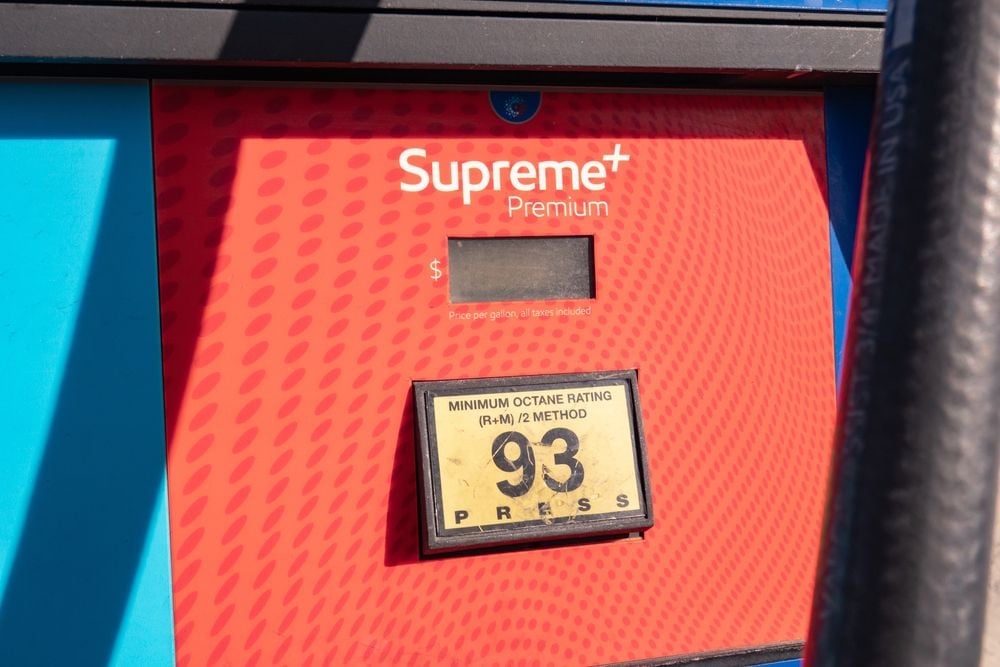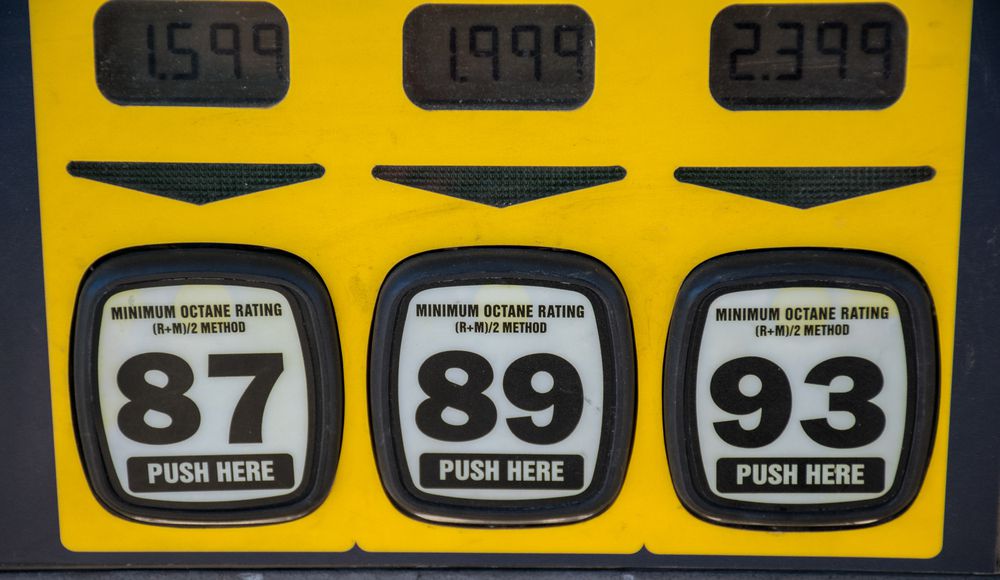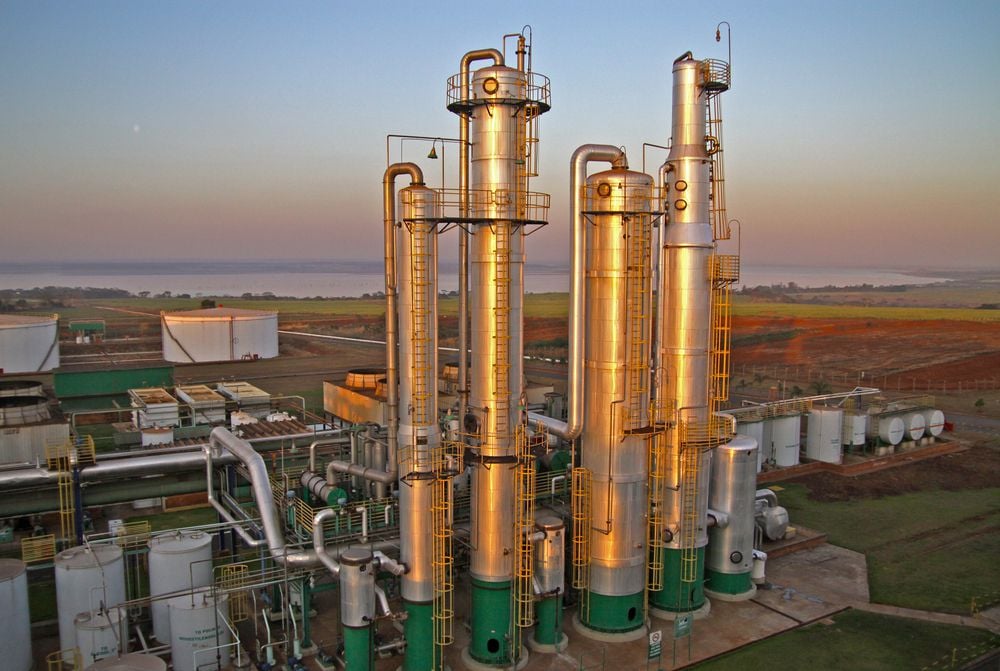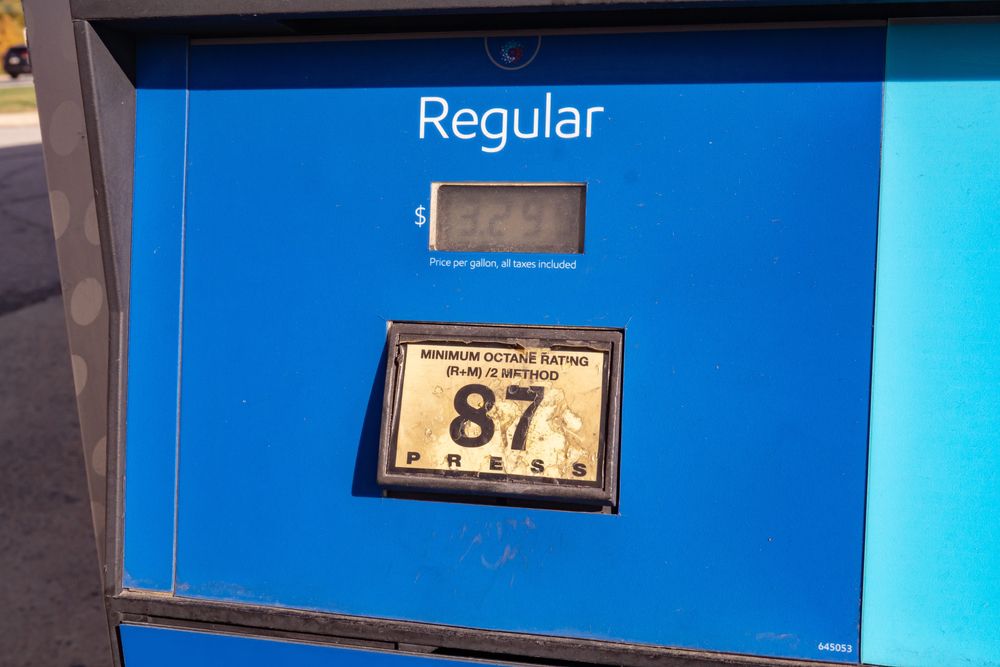
It's worth knowing how much ethanol is in 93 octane gas so you can better
understand your vehicle.
87 to 93 octane gasoline always contains either 10% or 15%, dubbed E-10
or E-15, respectively, and is used in most modern-day cars you'll see
on the road.
However, the corn-derived additive is also used to create flex fuel
which boasts a whopping 85% ethanol for special-use equipment and
vehicles.
We'll go over the several benefits of adding ethanol to gasoline, how it
affects the car, and whether gas stations sell fuel without ethanol in the
following sections.
 A gas pump with 93 octane gasoline.
A gas pump with 93 octane gasoline.
What Is Ethanol And How Does It Affect Your Engine?
Like gasoline, ethanol is a popular fuel type in the transportation sector.
While gasoline is a fossil fuel containing hydrocarbons, ethanol is made
from plants, making it a renewable resource.
Made from biomass (i.e., a range of plant materials), it contains the same
chemical formula regardless of whether it was made from sugar- or
starch-based feedstocks like sugar cane, corn, or wood chips and crop
residue.
Not only does ethanol help battle climate change, but it also has a higher
octane rating than regular gasoline, so you can use it in engines with
higher performances.
That said, it has a lower energy density than gasoline — 98% ethanol has
around 30% less energy per gallon than gasoline.
Therefore, you need more ethanol to travel the same distance as gasoline.
 Gas pump with multiple octanes.
Gas pump with multiple octanes.
Can You Mix Ethanol And Regular Gas
According to our blog post, you can mix regular gasoline with ethanol to achieve a higher octane rating
for your flex fuel vehicle.
The ratings dictate the ethanol percentage in the gasoline.
As per the USA's guidelines from the 1970s, all grades must contain some
amount of ethanol content.
Gasoline with an octane rating of 93, 92, 91, 90, 89, 88, or 87 boasts an
ethanol percentage of 10% or 15%, complying with the environmental
protection agency and its renewable fuel standard.
When ethanol is blended with gasoline, it forms E-10, E-15, and E-85 fuel
types, perfect for a range of vehicles.
E-10
E-10 fuel is gasoline mixed with 10% ethanol.
Once the corn-originating fuel was introduced into the industry in 1990, it
began at 10%.
The year marked the first time gasoline included an oxygenate to reduce
emissions and achieve increased octane ratings.
E-15
The E-15 version is a mix of 85% gasoline and 15% ethanol.
It made its first appearance in 2012 for use in vehicles manufactured after
2001 as many brands were already making engines that could handle the fuel
type without modifications.
E-85
Finally, E-85 is a blend of a whopping 85% ethanol and 15% gasoline.
It can be used in flex-fuel vehicles that are made to work with regular gas
or E-85 fuels.
Using this fuel reduces carbon dioxide emissions — the greenhouse gas
primarily responsible for climate change — by up to 30% compared to 93
octane and other fuels.
However, using it in a non-flex fuel vehicle can void your warranty and
cause undue engine damage.
 Ethanol plant in middle America.
Ethanol plant in middle America.
How The Ethanol Content Affects Your Car
Using ethanol-containing gasoline in your vehicle will bring these positive
effects:
-
Less-expensive maintenance costs —
Surprisingly, ethanol helps clean your car engine and stop
breakdown-causing deposits, extending the engine's lifespan and
boosting performance.
-
Reduce emissions —
Premium gasoline produces more damaging emissions than gasoline with
ethanol content. Ethanol burns cleaner to reduce emissions of
pollutants like carbon monoxide, particulate matter, and hydrocarbons.
-
Better fuel economy —
Since ethanol has a higher octane rating, it's well-suited to
premium-performing vehicles. And mixing it with regular gasoline
improves fuel economy because it ensures complete combustion in the
fuel system, wasting less energy.
Despite the positives, the potential downsides to using fuel with an
ethanol percentage, include:
-
Lower energy density —
This is the biggest downside to using gasoline with ethanol content. A
lower energy density means you'll need to fill up at gas stations more
often while traveling shorter distances.
-
Corrosive —
Over time, the corrosive aspects of ethanol can damage your car,
causing many people to turn to ethanol-free gas, despite the
environmental benefits. It mainly affects the seals and gaskets.
-
Costly —
The gasoline sold at fuel stops is cheaper than ethanol. Plus, you need
more ethanol to drive the same distance, increasing the price further.
-
Reduced power —
Due to the lower density, you won't get as much horsepower from your
car as gasoline.
How Much Ethanol Is In 93 Gasoline?
93 octane is a premium gas with a high octane rating.
Most 93 octane gas sold at fuel stations contain some ethanol content (10%
or 15%), however, some companies and states offer ethanol-free versions.
How Much Ethanol Is In 92 Octane Gas?
Gas with a 92 octane rating can contain 10% or 15% of ethanol content.
Any gasoline with a rating of 91 or more is known as premium gas, made for
use in luxury vehicles.
A higher octane level proves trickier to ignite, preventing pre-ignition
and engine knocks in high-performing cars.
Constantly using the regular gas pump to fill these cars will cause
problems in the long run.
How Much Ethanol Is In 90 Octane Gas?
Again, you can expect to find either 10% or 15% of ethanol in gasoline with
a 90 rating.
However, REC-90 is an ethanol-free version designed for marine or
recreational engines that require low or less ethanol to run.
How Much Ethanol Is In 88 Octane Gas?
Unleaded 88 gasoline contains an ethanol content of 15%.
Companies make it by combining ethanol with 84 octane gasoline.
 87 octane gas pump.
87 octane gas pump.
How Much Ethanol Is In 87 Octane Gas?
Most of the cars sold in the United States of America (82%) use gasoline
with an octane rating of 87 rather than 93 octane premium gas.
It comes in E-10 and E-15 forms and is well-suited for low- and mid-segment
SUVs, cars, and trucks.
That said, always check your owner's manual as some cars can't run on fuel
type as it causes an engine knock (i.e., a loud banging sound from under
the hood).
If your car does take this fuel, don't fill your tank with premium gasoline
because the engines aren't manufactured for it.
Normally, the cars that don't work with this gas are premium brands, sports
vehicles, cars with larger-than-average engines, and automobiles with a
turbocharger.
These cars tend to require gas with a 91, 92, or 93 octane rating.
How Much Ethanol Is In 85 Octane Gas?
Contrary to popular belief, E-85 flex fuel isn't the same as 85 octane gas
— E-85 refers to the 85% of ethanol in the gas and is not an octane rating.
Like the other regular gasoline types, 85 fuel has either 10% or 15%
ethanol content.
What Octane Is Ethanol Free Gas?
95 octane is a gas free from ethanol, therefore containing no alcohol.
It's usually utilized in limited-use engines and seasonal equipment to
ensure a minimum level of corrosion and damage to the sensitive components.
Several countries (mainly around Europe) prefer gas with less ethanol, so
you'll mainly find 87 octane gas in these areas as it only contains 10%
ethanol.
How Much Ethanol Is In Premium Gas?
Ethanol is a standard addition to most premium gas brands around the United
States of America, thanks to its ability to reduce knocking and improve
combustion.
The majority of premium gas contains 10% ethanol; however, you will find a
few brands with zero alcohol content.
Which Gas Has Least Ethanol?
As we've mentioned, you can find gas with no ethanol content, particularly
the premium type.
That said, the no-ethanol gases are best saved for seasonal equipment or
limited-use engines.
E-10 and E-15 variants are great for most cars you'll purchase and drive
today.
Can You Mix 87 and 89 Gas?
Most likely, mixing 87 and 89 octane gas will not harm your car. However,
your car's engine must be designed to run on less than 89 octane gas.
When you create a mixture of half 87 octane gas and half 89 octane gas, you
get 88 octane gas.
If your car runs on 87 octane gas, mixing 87 and 89 gas to get 88 octane
gas will not improve its performance.
Similarly, if your car requires 89 octane gas or better, mixing 87 and 89
gas will reduce its performance.
Most gas stations that sell 87, 89, and 91 octane gas have a mixer pump and
a tank containing these octane gasses. This mixer pump combines two
different octane grades, depending on your vehicle's needs.
Luxury Cars That Use 87 and 89 Octane Gas
The minimum octane rating of your car is usually on the manual. 87 octane
gas is "regular," and 89 octane gas is "mid-grade." Contrary to the popular
belief that luxury cars run on premium gas( 91 octane gas), various brands
can operate under 87 and 89 octane gas. Some of these are:
-
Audi A3; 2.0-liter turbo four
-
Audi Q3; 2.0-liter turbo four
-
Audi TT; 2.0-liter turbo
-
Cadillac XT5; 3.6-liter V6
-
Cadillac XT6; 3.6-liter V6
-
Lexus ES; 2.5-liter hybrid four; 3.5-liter V6
-
Lexus NX; 2.5-liter four
Conclusion
Now you know exactly how much ethanol is in 93 octane gas — those with
ratings between 87 to 93 contain at least 10% and at most 15% ethanol.
The clean air act dictated the need for all gasoline sold to contain
ethanol to reduce emissions and combat pollution.
Most vehicles in the United States of America run on 87 octane gasoline,
but the best type for your car will vary depending on its engine, the
presence of a turbocharger, and other factors.
Although, you can find gasoline without ethanol to fill up recreational and
marine vehicles.
However, E-85 gasoline contains 85% ethanol and is designed for use in a
flex-fuel system.
Always check your owner's manual to find out whether you need E-10 or E-15
gas for the best driving experience.